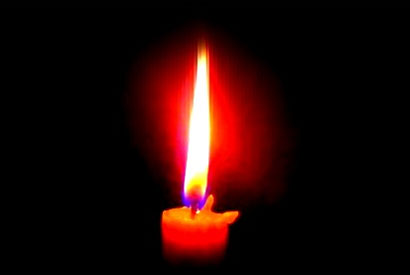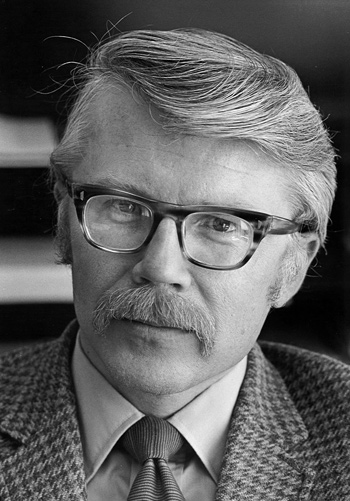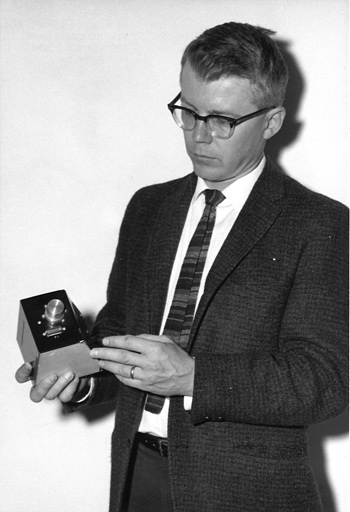Pioneering space physicist Kinsey Anderson has died at 85
Kinsey A. Anderson, a professor emeritus of physics and an international leader in the field now called space physics, died June 11, 2012, at the age of 85.

June 29, 2012
Kinsey A. Anderson, a professor emeritus of physics at the University of California, Berkeley, and an international leader in the field now called space physics, died June 11 in an assisted living facility in Pinole, Calif. He was 85 and suffered from Alzheimer’s disease.

Kinsey A. Anderson in the 1980s.
For four decades, Anderson built experiments that flew on balloons, rockets and satellites and helped explain the nature of Earth’s aurora, or northern lights; solar flares and solar energetic particles; the solar wind sweeping through space; and the structure of Earth’s magnetic “tail.”
While a graduate student at the University of Minnesota in the early 1950s, he was a member of the group that first developed balloons that could take experiments to high altitudes in order to study cosmic rays and X-rays that are blocked by the atmosphere. He used these balloons, and later sounding rockets, to study high-energy cosmic rays and particles from the sun.
At UC Berkeley, he designed and built more advanced instruments that flew on over two dozen satellites. He convinced NASA that the Apollo 15 and 16 missions, which landed on the moon in the early 1970s, should carry subsatellites that could be left in lunar orbit. The goal was to measure the shadowing of energetic electrons by the moon to determine the motion of Earth’s magnetic tail, but he and former student Robert Lin, now a UC Berkeley professor of physics, discovered that electron detectors could also be used to measure the magnetic field on the surface of the moon. Lin subsequently built instruments for the Lunar Prospector and Mars Global Surveyor that used this technique to map the surface magnetic fields of the moon and Mars.
“It was a time of great discovery in space, and Kinsey opened up the entire field of space physics, helping to understand new phenomena that had never been seen before,” Lin said. “It was a very exciting time.”
In 1986, he and Lin also built detectors that flew aboard the European Space Agency’s Giotto spacecraft to sample gases coming off Halley’s Comet.
Anderson served for 10 years (1970-79) as director of UC Berkeley’s Space Sciences Laboratory (SSL).During that time, the laboratory became a world leader in space research, said Lin, who subsequently served as SSL director.
Born in Preston, Minn., on Sept. 18, 1926, Anderson graduated from Carleton College in Minnesota in 1949 with a B.A. in physics and joined the University of Minnesota group that conducted the original research and development of balloons later used for high altitude research. He was awarded a patent for a novel method of measuring stresses in balloon material for different shapes of balloons.
For his Ph.D. thesis under University of Minnesota professor John Winckler, he used the balloon technology to measure cosmic rays at various latitudes and altitudes, even launching balloons from a U.S. aircraft carrier in the South Pacific. After completing his thesis in 1955, he accepted a post-doctoral position at the University of Iowa, where he subsequently joined the faculty in 1958.
Piqued by unexpected X-rays that he and Winckler had discovered emanating from the atmosphere above Northern Canada, Kinsey focused on X-ray detectors and established, by direct observations at high altitudes, that intense fluxes of very energetic protons are emitted by the sun during solar flares.
He joined the UC Berkeley physics department in 1960 and switched to the then-new technology of satellite instrumentation to study particles and X-rays from the sun. During the next 10 years, he and his students successfully flew instruments on more than a dozen spacecraft, “which may be a record number for any individual or research group,” Lin said. The space vehicles included IMP (Interplanetary Monitoring Platform) 1-6, Explorers 33 and 35, OGO (Orbiting Geophysical Observatory) 5, and the Apollo 15 and 16 subsatellites.
“A characteristic of this work was Kinsey’s unselfish leadership, which enabled his students to manage all aspects of their own research programs,” said SSL colleague Forrest Mozer, UC Berkeley professor emeritus of physics. “This approach produced scientists who are world leaders in research fields initiated by Kinsey and colleagues who appreciated Kinsey’s assistance in establishing their own research programs.”

Anderson in the early 1960s holding an instrument he built for one of NASA’s IMP (Interplanetary Monitoring Platform) satellites.
As SSL director, Anderson initiated a senior fellow program that allowed research scientists to become principal investigators, thus able to handle the administrative and technical burdens associated with the special needs of space flight programs.
Kinsey was an author of approximately 200 papers and trained 24 graduate students on such diverse topics as instrument design; auroral, solar and cosmic x-ray emissions; energetic particles from the sun, Earth’s bow shock, magnetosphere and tail; the plasma physics of Halley’s Comet; and remnant magnetic fields of the moon and Mars.
His research achievements resulted in his election as a member of the National Academy of Sciences. He also received a Guggenheim Fellowship, the Space Science Award from the American Institute of Astronautics and Aeronautics, a NASA Medal for Exceptional Scientific Achievement, the Alexander von Humboldt Award, fellowships in the American Geophysical Union, the American Physical Society and the American Association for the Advancement of Science, as well as an honorary doctorate from the University of Toulouse. Upon his retirement from UC Berkeley in 1990, Kinsey received the Berkeley Citation for distinguished achievement and notable service to the university.
“Kinsey is remembered not only as a preeminent scientist, but as a humble, curious and witty man whose interests in art, music, nature and culture enriched the lives of all who knew him,” said SSL physicist George Parks.
Anderson is survived by his wife, Lilica Anderson (née Vassiliades) of El Cerrito; daughters Sindri Anderson of El Cerrito and Danae Anderson of Truckee, Calif.; and five grandchildren.
A memorial service is being planned for September.